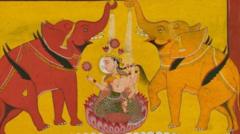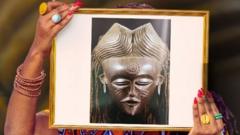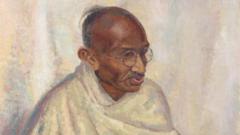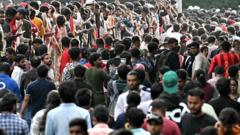Recent exhibitions across India are redefining the narrative around local textiles, with an emphasis on inclusivity and historical significance.
Reviving India’s Textile Heritage: An Exploration of Gamchha and Beyond

Reviving India’s Textile Heritage: An Exploration of Gamchha and Beyond
A focus on traditional Indian textiles through innovative exhibitions is giving forgotten artisans renewed recognition.
In an era where fashion often takes center stage, a series of exhibitions showcasing India’s rich textile heritage is reminding the public of the deep-rooted artistry inherent in local practices. From the humble gamchha—a versatile scarf used in multiple ways—to intricate embroideries from nomadic tribes, these shows are restoring visibility to the weavers and craftsmen whose contributions have long been overshadowed.
One of the standout exhibitions held recently in Delhi, “Gamchha: From the Ordinary to the Extraordinary,” elucidated the history and cultural variations of this iconic fabric. Showcasing 250 pieces from 14 states, the exhibition demonstrated the diverse interpretations of the gamchha, featuring examples from Kerala’s delicate bordered gamchhas to the vibrant embroidered cotton gamusas of Assam. This exhibition underlined the social significance of the fabric, highlighting its role as a symbol of equality and the lifestyle of the working class, according to Jaya Jaitly, founder of the Dastkari Haat Samiti, which organized the event.
As part of a broader movement, various art and craft foundations are curating exhibitions across the country to bring forth different aspects of Indian textiles. Unlike the glamorous fashion showcases usually associated with Bollywood stars, these exhibits seek to highlight local artisans and connect them back to their roots without the overshadowing influence of urban fashion designers. According to Ritu Sethi of the Crafts Revival Trust, digital platforms are playing a crucial role in shedding light on these often anonymous craftspeople, fostering a more equitable textile ecosystem.
Not only do these exhibitions offer a glimpse of textiles' aesthetic richness, but they also delve into the complex narratives tied to social, caste, and class struggles. For instance, “Textiles of Bengal: A Shared Legacy” celebrates the region’s rich weaving traditions, featuring pieces from as far back as the 17th Century, while encouraging discussions about the cultural histories that bind India and Bangladesh.
Other exhibitions, like “Take Pampa: Textiles of Karnataka,” present the unique textile histories of various communities, showcasing works from local tribes and artisans, emphasizing their narratives of resilience and survival through fabric. Additionally, innovative art exhibits, such as “Surface: An Exhibition of Indian Embroideries,” bridge the gap between textiles and fine art, showcasing how fabric can transcend conventional boundaries.
Through support from foundations like the Devi Art Foundation, there is a renewed focus on documenting and archiving Indian textiles—a task often overlooked by even prestigious fashion institutes. The project “Pehchaan: Enduring Themes in Indian Textiles” strives to connect the past with contemporary design practices by highlighting themes that have persisted for centuries.
With the success of these exhibitions, curators are optimistic about cultivating a vibrant future for Indian textile arts. As Mayank Mansingh Kaul notes, the commitment to building a creative ecology supports the growth of new audiences and inspires emerging designers to seek quality and relevance in their work.
As this revival movement gathers momentum, it serves as a powerful reminder of the cultural narrative weavings that define India, shedding light on the often-overlooked artisans whose stories are integral to the nation’s textile tapestry.
One of the standout exhibitions held recently in Delhi, “Gamchha: From the Ordinary to the Extraordinary,” elucidated the history and cultural variations of this iconic fabric. Showcasing 250 pieces from 14 states, the exhibition demonstrated the diverse interpretations of the gamchha, featuring examples from Kerala’s delicate bordered gamchhas to the vibrant embroidered cotton gamusas of Assam. This exhibition underlined the social significance of the fabric, highlighting its role as a symbol of equality and the lifestyle of the working class, according to Jaya Jaitly, founder of the Dastkari Haat Samiti, which organized the event.
As part of a broader movement, various art and craft foundations are curating exhibitions across the country to bring forth different aspects of Indian textiles. Unlike the glamorous fashion showcases usually associated with Bollywood stars, these exhibits seek to highlight local artisans and connect them back to their roots without the overshadowing influence of urban fashion designers. According to Ritu Sethi of the Crafts Revival Trust, digital platforms are playing a crucial role in shedding light on these often anonymous craftspeople, fostering a more equitable textile ecosystem.
Not only do these exhibitions offer a glimpse of textiles' aesthetic richness, but they also delve into the complex narratives tied to social, caste, and class struggles. For instance, “Textiles of Bengal: A Shared Legacy” celebrates the region’s rich weaving traditions, featuring pieces from as far back as the 17th Century, while encouraging discussions about the cultural histories that bind India and Bangladesh.
Other exhibitions, like “Take Pampa: Textiles of Karnataka,” present the unique textile histories of various communities, showcasing works from local tribes and artisans, emphasizing their narratives of resilience and survival through fabric. Additionally, innovative art exhibits, such as “Surface: An Exhibition of Indian Embroideries,” bridge the gap between textiles and fine art, showcasing how fabric can transcend conventional boundaries.
Through support from foundations like the Devi Art Foundation, there is a renewed focus on documenting and archiving Indian textiles—a task often overlooked by even prestigious fashion institutes. The project “Pehchaan: Enduring Themes in Indian Textiles” strives to connect the past with contemporary design practices by highlighting themes that have persisted for centuries.
With the success of these exhibitions, curators are optimistic about cultivating a vibrant future for Indian textile arts. As Mayank Mansingh Kaul notes, the commitment to building a creative ecology supports the growth of new audiences and inspires emerging designers to seek quality and relevance in their work.
As this revival movement gathers momentum, it serves as a powerful reminder of the cultural narrative weavings that define India, shedding light on the often-overlooked artisans whose stories are integral to the nation’s textile tapestry.




















